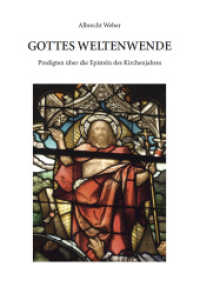- ホーム
- > 洋書
- > ドイツ書
- > Social Sciences, Jurisprudence & Economy
- > Politics, Society, Work
- > miscellaneous
Full Description
This volume explores the complex nature of religiosity among deaf and hard-of-hearing adolescents attending residential schools in Poland. Drawing on psychological models of religion, particularly Stefan Huber's multidimensional approach, this study examines both subjective and environmental determinants of religious development in this unique population. Key dimensions include emotional experiences of the divine, conceptual images of God, and general levels of religious commitment, all measured through standardized tools adapted for Polish Sign Language users. The book also offers a comprehensive profile of the participants, including their developmental trajectories, communication methods, and varying degrees of religious knowledge and engagement. It also analyzes the role of educational and social environments in shaping religious identity and practices. Drawing from data collected from 170 students across Poland, the study develops an evidence-based model for religious education tailored to deaf and hard-of-hearing youth, including post-educational and elderly groups in inclusive education settings. The book fills a major gap in both Polish and international scholarship, and ultimately provides essential insights for educators, religious leaders, psychologists, and policymakers engaged in the inclusive religious formation of deaf and hard-of-hearing individuals.
Contents
Chapter 1.Deaf and hard of hearing people - an introduction to the issue.- Chapter 2. Human religiosity.- Chapter 3 . Religious education of deaf and hard of hearing youths.- Chapter 4. Methodology of Self-Study.- Chapter 5. The structure of religiosity and religious knowledge of deaf and hard of hearing youth - presentation of the results of our own research.- Chapter 6. The structure of the relationship of religiosity and its content with selected variables in deaf and hard of hearing adolescents studied.- Chapter 7. Discussion of the obtained results of our own research and implications of the research.








